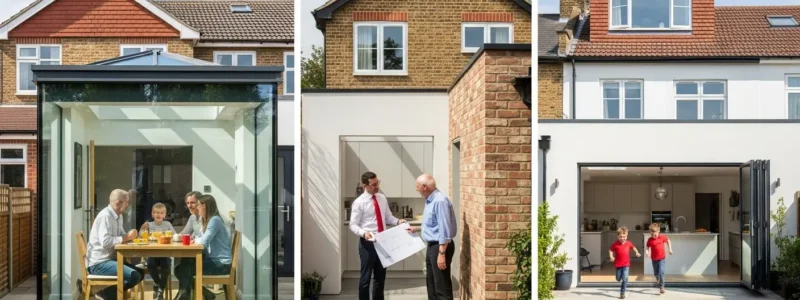Thinking about a home extension can feel daunting with all the rules, paperwork, and design choices. Yet the number of UK planning applications for home extensions reached over 60,000 last year alone. Most people get stuck at the very first hurdle and miss out on opportunities to create spaces that work for their families. The real secret is that careful groundwork not only saves money but also makes the whole project much smoother and more enjoyable than you might expect.
Table of Contents
- Step 1: Assess Your Current Space Requirements
- Step 2: Research Local Planning Regulations
- Step 3: Create A Comprehensive Design Brief
- Step 4: Budget For Your Home Extension Project
- Step 5: Hire The Right Professionals For Your Project
- Step 6: Monitor Progress And Ensure Compliance
Quick Summary
| Key Point | Explanation |
|---|---|
| 1. Assess Current Space Requirements | Conduct a room-by-room evaluation to identify spatial needs, helping lay the foundation for effective home extension plans. |
| 2. Research Local Planning Regulations | Engage with the local planning authority to understand guidelines and permitted development rights that affect your extension’s feasibility. |
| 3. Create a Comprehensive Design Brief | Document your vision, functional needs, and aesthetics in a clear brief, ensuring alignment with professionals executing the project. |
| 4. Budget for the Extension Project | Establish a detailed budget including contingencies to accommodate unforeseen expenses, thus ensuring financial control throughout the project. |
| 5. Hire the Right Professionals | Select experienced professionals who understand local regulations and share your vision, laying the groundwork for a successful collaboration. |
Step 1: Assess Your Current Space Requirements
Planning a home extension begins with a comprehensive evaluation of your current living space and understanding your specific spatial needs. This critical initial step determines the foundation of your entire home improvement project, ensuring that your extension will genuinely enhance your lifestyle and property value.
Start by conducting a thorough room-by-room assessment of your existing home. Walk through each space with a critical eye, identifying areas of congestion, underutilisation, and potential functionality improvements. Measure current room dimensions precisely, noting not just square footage but how spaces are actually used by your household. Pay special attention to high-traffic areas like kitchens, living rooms, and bedrooms where space constraints are most apparent.
Consider your family’s evolving needs when evaluating space requirements. Are you planning for growing children, anticipating elderly parent care, or seeking dedicated home office space? These future considerations are crucial in determining the scope and design of your extension. According to UK Government Housing Standards, understanding your long-term spatial requirements helps create a more sustainable home improvement strategy.
Document your findings systematically. Create a detailed sketch or digital floor plan highlighting current limitations and potential expansion opportunities. Include notes on natural light, existing architectural features, and potential structural challenges. This comprehensive documentation will prove invaluable when consulting with architects, builders, and planning authorities.
Remember that successful home extensions are not just about adding square metres but creating meaningful, functional living spaces that integrate seamlessly with your existing home. Your initial assessment should reveal not just where you need more space, but how that space can fundamentally improve your daily living experience.
Step 2: Research Local Planning Regulations
Navigating the complex landscape of local planning regulations is a crucial step in your home extension journey. Understanding these regulations will prevent potential legal complications and ensure your project moves forward smoothly. Every local council has specific guidelines that can significantly impact your extension plans, making thorough research an essential preliminary task.
Begin by contacting your local planning authority directly. Most local councils provide detailed guidance about home extension requirements, and speaking with a planning officer can offer invaluable insights specific to your property and neighbourhood. According to UK Government Planning Guidelines, different areas have unique restrictions based on factors like conservation zones, listed building status, and local architectural characteristics.
Carefully examine permitted development rights for your specific property. These rights determine what improvements you can make without requiring full planning permission. Some extensions might be possible under these rights, potentially saving time and reducing bureaucratic hurdles. However, these rights come with precise measurements and design constraints that must be meticulously followed.
Prepare comprehensive documentation that demonstrates how your proposed extension complies with local regulations. This typically includes detailed architectural drawings, site plans, and impact assessments. Precise measurements and proposed design specifications are critical. Some councils require additional documentation like heritage impact statements or ecological surveys, depending on your property’s location and characteristics.
Remember that planning regulations are not just bureaucratic hurdles but mechanisms designed to maintain neighbourhood character and protect community interests. By approaching this stage with patience, thoroughness, and a collaborative mindset, you increase the likelihood of gaining planning approval. Your goal is to develop a proposal that meets both your personal needs and the broader community’s architectural and aesthetic standards.
The following table provides a checklist of key documentation and compliance aspects required when researching local planning regulations for a home extension in the UK.
| Documentation/Requirement | Purpose | Notes on Importance |
|---|---|---|
| Detailed architectural drawings | Illustrate proposed extension designs | Essential for planning applications |
| Site plans | Show positioning and context of extension | Required by local planning authorities |
| Impact assessments | Assess environmental and neighbour impact | May influence permission in sensitive areas |
| Heritage impact statements | Address effects on heritage or listed buildings | Often needed in conservation zones |
| Precise measurements and designs | Ensure compliance with permitted development rules | Avoids breaches and potential refusals |
| Ecological surveys | Evaluate local ecological effects | Needed for some rural or protected locations |
| Proposed material specifications | Specify external finishes and materials | Aligns with area aesthetic guidelines |
Step 3: Create a Comprehensive Design Brief
Creating a comprehensive design brief transforms your home extension from a vague concept into a tangible, actionable plan. This critical document serves as a roadmap that communicates your vision, functional requirements, and aesthetic preferences to architects, builders, and contractors. A well-crafted design brief ensures everyone involved understands the project’s scope, reducing potential misunderstandings and costly modifications later.
Begin by articulating the primary purpose of your extension. Are you seeking additional living space, a modern kitchen, a home office, or a multifunctional area? Be explicit about how this new space will improve your daily life. Consider your household’s unique dynamics – the number of occupants, their ages, lifestyle needs, and future plans. These details will significantly influence the design’s functionality and layout.
According to UK Government’s National Design Guide, a robust design brief should encompass more than just spatial requirements. Include detailed information about your preferred architectural style, desired materials, colour palettes, and how the extension will harmonise with your existing property. Explore visual references through magazines, online platforms, and architectural websites to help communicate your aesthetic vision clearly.
Document technical specifications with precision. Outline exact room dimensions, ceiling heights, window placements, and natural light requirements. Consider practical elements like electrical outlet locations, heating systems, storage solutions, and potential technological integrations. Think about long-term adaptability – design a space that can evolve with your changing needs.
Finally, establish a realistic budget range and project timeline. Be transparent about financial constraints and desired completion dates. A comprehensive design brief is a living document that will be refined through consultations with professionals, but its initial clarity sets the foundation for a successful home extension project.
By investing time in developing a detailed, thoughtful brief, you significantly increase the chances of creating a space that truly reflects your lifestyle and enhances your home’s functionality.

Step 4: Budget for Your Home Extension Project
Budgeting for your home extension is a nuanced process that requires careful financial planning and realistic expectations. This step transforms your design vision into a financially viable project, balancing your aspirations with economic practicality. Successful budgeting goes beyond simple cost calculations and involves strategic financial management throughout the entire project lifecycle.
Begin by establishing a comprehensive budget that includes hard construction costs, professional fees, and potential contingency expenses. According to UK National Association of Building Contractors, extension costs can vary significantly based on quality, location, and design complexity. For a standard 4m x 5m extension, budget ranges typically span from 35,000 to 50,000, not including professional fees which can add another 10-15% to your total project cost.
Incorporate financial buffer zones into your budget to accommodate unexpected challenges. Experienced homeowners recommend setting aside 10-15% of your total budget for unforeseen expenses like structural modifications, material price fluctuations, or additional design refinements. This financial cushion provides peace of mind and prevents project stagnation when unexpected costs arise.
Explore multiple financing options to support your extension project. Consider options like remortgaging, personal loans, or home improvement grants. If you’re looking for extensions in specific areas like Islington, local financial resources and region-specific incentives might be available. Consult with financial advisors who specialize in home improvement funding to understand the most suitable approach for your specific circumstances.
Carefully track and document all expenses throughout the project. Maintain a detailed spreadsheet that records every expenditure, comparing actual costs against your initial budget. This systematic approach allows you to make real-time adjustments, prevent budget overruns, and ensure financial transparency with all involved professionals. By treating your home extension budget as a dynamic, living document, you’ll maintain greater control over your project’s financial health.
This table summarises common budget categories and typical percentage allocations to help you organise a realistic home extension budget as described in the article.
| Budget Category | Typical Percentage of Total Budget | Description |
|---|---|---|
| Construction costs | 70-80% | Main building work, structural changes, materials |
| Professional fees | 10-15% | Architects, engineers, project managers |
| Contingency fund | 10-15% | Unexpected expenses and overruns |
| Permits & approvals | Variable | Fees for planning and building regulations |
| Fixtures & finishes | Variable | Kitchens, bathrooms, flooring, decor |
| Project management tools | <1% | Cost of spreadsheets/software for tracking |

Step 5: Hire the Right Professionals for Your Project
Hiring the right professionals is a pivotal moment in your home extension journey, transforming your carefully crafted design brief into a tangible reality. This step requires strategic selection, thorough vetting, and clear communication to ensure your project’s success. The professionals you choose will significantly impact the quality, efficiency, and ultimate satisfaction of your home extension.
Begin by identifying the key professionals required for your project. Typically, this includes an architect, structural engineer, and a reputable building contractor. Seek recommendations from trusted sources, including friends, family, and professional networks. According to UK Government Building Regulations, it is crucial to engage professionals who are familiar with local building codes and can navigate complex regulatory requirements.
Conduct comprehensive interviews and request detailed portfolios from potential professionals. Look beyond glossy presentations and examine their previous work, focusing on projects similar to your home extension. Request references and take the time to contact their past clients. Pay attention to how well they communicate, their responsiveness, and their ability to understand and interpret your design vision. If you are considering extensions in specific areas like Islington, local professionals with regional expertise can be particularly valuable.
Establish clear contractual agreements that outline project scope, timelines, payment schedules, and potential contingencies. Ensure all professionals are properly accredited and carry appropriate insurance. This protects you from potential financial and legal complications should unexpected issues arise during the construction process. A well-drafted contract serves as a roadmap, providing clarity and setting expectations for all parties involved.
Remember that successful collaboration is about more than technical skills. Choose professionals who demonstrate genuine enthusiasm for your project, show flexibility, and are committed to turning your home extension vision into reality. Your ability to establish a strong, communicative relationship with your project team will be instrumental in navigating the complex journey of home renovation.
Step 6: Monitor Progress and Ensure Compliance
Monitoring progress and ensuring compliance is the critical phase that transforms your home extension from blueprint to reality. This step demands active engagement, meticulous attention to detail, and a proactive approach to managing your construction project. Effective monitoring protects your investment and ensures your extension meets all legal, structural, and design requirements.
Establish a robust communication framework with your project team from the outset. Schedule regular on-site meetings, ideally weekly, to review progress, discuss potential challenges, and make real-time decisions. According to UK Government Building Regulations, maintaining comprehensive documentation throughout the construction process is essential for demonstrating compliance and managing potential future inspections.
Develop a detailed tracking system that monitors both progress and expenditure. Create a comprehensive spreadsheet or use project management software to log every aspect of the build, including timelines, budget allocations, materials used, and completed milestones. For those undertaking extensions in areas like Islington, local regulatory nuances make meticulous record-keeping even more crucial. Pay particular attention to key stages such as foundation work, structural modifications, and final finishing, ensuring each phase meets your agreed specifications and building regulations.
Be prepared to address unexpected challenges swiftly and professionally. Maintain open, constructive communication with your contractors, focusing on solutions rather than blame. If discrepancies arise between the original design and actual construction, document them thoroughly and discuss potential adjustments. Your goal is to preserve the integrity of your original vision while remaining flexible enough to accommodate practical realities.
Consider engaging an independent building inspector to provide an unbiased assessment of the work’s quality and compliance. These professionals can offer valuable third-party verification, ensuring that your extension not only meets legal requirements but also adheres to the highest construction standards. By maintaining vigilant oversight and a collaborative approach, you’ll navigate the complexities of home extension with confidence and precision.
Ready to Transform Your Home Extension Plans Into Reality?
You have spent valuable time assessing your home, researching regulations, and developing a thoughtful brief. Still, turning these plans into a successful extension can feel overwhelming. Whether the challenge is navigating planning permission, ensuring precise budgeting, or choosing the right professionals for a seamless experience, each step carries its own risks and uncertainties. If you want expert guidance and a stress-free process from concept to completion, our team at Reltic Extend is here to deliver. With over 20 years of experience and hundreds of happy homeowners, we specialise in managing every detail of your bespoke home extension, including rear, side, and double-storey projects, across London and Surrey.
Stop letting uncertainty delay your dream living space. Use our transparent cost calculator and explore practical design advice tailored to your lifestyle. If you are serious about maximising space, improving functionality, and protecting your investment with a 10-year structural warranty, reach out to our team today. Receive a clear, stage-by-stage plan and let us take care of planning permissions, budgeting, and project management. The sooner you contact us, the sooner you can enjoy a modern, expertly finished extension made to suit you. Contact Reltic Extend now and ensure your next step is the right one for your home.
Frequently Asked Questions
What is the first step in planning a home extension?
Assessing your current space requirements is the initial step. It involves evaluating your existing living space, identifying areas that need improvement, and understanding your family’s future spatial needs.
How do I navigate local planning regulations for my extension?
Start by contacting your local planning authority to understand specific guidelines. Research permitted development rights for your property, and prepare comprehensive documentation demonstrating compliance with local regulations.
What should be included in a design brief for a home extension?
A comprehensive design brief should articulate the primary purpose of your extension, preferred architectural style, materials, and layouts. Include technical specifications such as room dimensions and desired features to ensure clear communication with professionals.
How can I budget effectively for my home extension project?
Establish a comprehensive budget that covers hard construction costs, professional fees, and a contingency fund of 10-15% for unexpected expenses. Track all expenditures meticulously to manage finances throughout the project.
Recommended
- Home Extensions Islington | Builders Islington | Reltic Extend
- Archiwa kitchen extension ideas – Reltic Extend
- Archiwa home extension budget – Reltic Extend
- Archiwa modern home extension – Reltic Extend
- Master the Art: How to Measure Windows for UK Homes





